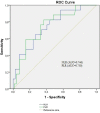Association of Platelet to Lymphocyte and Neutrophil to Lymphocyte Ratios with In-Hospital Mortality in Patients with Type A Acute Aortic Dissection
- PMID: 31545575
- PMCID: PMC6894039
- DOI: 10.21470/1678-9741-2018-0343
Association of Platelet to Lymphocyte and Neutrophil to Lymphocyte Ratios with In-Hospital Mortality in Patients with Type A Acute Aortic Dissection
Abstract
Objective: To evaluate the relationship between neutrophil to lymphocyte ratio (NLR) and platelet to lymphocyte ratio (PLR) with in-hospital mortality in type A acute aortic dissection (AAD).
Methods: A total of 96 patients who presented to the emergency department between January 2013 and June 2018 with a diagnosis of type A AAD were enrolled in this study. White blood cell count subtypes such as NLR and PLR were calculated at the time of admission. The end point was in-hospital mortality.
Results: Of the 96 type A AAD patients included in this analysis, 17 patients (17.7%) died during hospitalization. NLR and PLR were significantly elevated in patients with type A AAD (P<0.001 and <0.001, respectively). Based on the receiver operating characteristic curve, the best NLR cut-off value to predict in-hospital mortality was 9.74, with 70.6% sensitivity and 76.8% specificity, whereas the best PLR cut-off value was 195.8, with 76.5% sensitivity and 78.1% specificity.
Conclusion: Admission NLR and PLR levels were important risk factors and independently associated with in-hospital mortality of type A AAD patients.
Keywords: Aneurysm, Dissecting; Blood Platelets; Hospital Mortality; Hospitalization; Leukocyte Count; Lymphocytes; Risk Factors.
Conflict of interest statement
Figures



Comment in
-
Predictive Value of White Blood Cells, Neutrophils, Platelets, Platelet to Lymphocyte and Neutrophil to Lymphocyte Ratios in Patients with Acute Aortic Dissection.Braz J Cardiovasc Surg. 2020 Dec 1;35(6):1031-1033. doi: 10.21470/1678-9741-2020-0144. Braz J Cardiovasc Surg. 2020. PMID: 33113320 Free PMC article. No abstract available.
-
Admission Time and Surgical Technique are Important in Aortic Dissection Treatment Results.Braz J Cardiovasc Surg. 2020 Oct 29;35(5):849-850. doi: 10.21470/1678-9741-2020-0085. Braz J Cardiovasc Surg. 2020. PMID: 33118756 Free PMC article. No abstract available.
-
Prognostic Value of Dynamic Monitoring of Platelet Counts and Red Cell Distribution Width to Platelet Ratio in Patients with Acute Type A Aortic Dissection.Braz J Cardiovasc Surg. 2020 Oct 29;35(5):852-855. doi: 10.21470/1678-9741-2020-0132. Braz J Cardiovasc Surg. 2020. PMID: 33118758 Free PMC article. No abstract available.
References
-
- Shen XH, Chen Q, Shi Y, Li HW. Association of neutrophil/lymphocyte ratio with long-term mortality after ST elevation myocardial infarction treated with primary percutaneous coronary intervention. Chin Med J. 2010;123(23):3438–3443. - PubMed
MeSH terms
Substances
LinkOut - more resources
Full Text Sources
